Gas fireplace most frequently asked questions regarding maintenance, potential issues, and more…
Q. Do gas fireplaces need a chimney?
Not in the traditional sense! Gas fireplaces do require venting and there are different options to help with this. Direct vent gas fireplaces have their own venting system that draws out fresh air from outside for combustion. This expels exhaust gasses through the dedicated venting system. Vent-free fireplaces release minimal exhaust into a room with its efficient burning and use an existing chimney or vent system to remove the exhaust.
Q. Why won’t my gas fireplace turn on?
There can be a few common reasons why your gas fireplace is not turning on. Start by checking the gas supply if using a propane gas fireplace. If the propane tank is off or low, the fireplace will not ignite. Next, check the pilot light or ignition switch. If the pilot light is not lit, follow the manufacturer’s instructions to relight it or check out this video here. Often times, gas fireplace can use an electronic ignition system so listen for clicking sounds when you attempt to turn it on. If you don’t hear clicking, there might be an issue with the ignition system that requires professional attention. The electric ignition system also requires a power source so be sure to check it is properly plugged in! Blown fuses or tripped circuit breakers would also affect the power supply. Some gas fireplaces are controlled by a thermostat or remote control. Be sure to check the thermostat to make sure it’s set at the desired temperature and the remote control has working batteries. Sometimes issues with these controls can prevent the fireplace from turning on as a safety feature! If you are able to correctly identify the gas valve within your fireplace, check to ensure it is set at “on”. It is best to have a professional check this however, if you are unfamiliar with gas lines and valves. (No shame in this, we all start somewhere!)
Remember, working with gas appliances can be dangerous if you’re not familiar with them so it’s always safer to seek professional assistance if none of these helped resolve the issue.
Q. Can a gas fireplace produce carbon monoxide?
Yes! Gas fireplaces can produce carbon monoxide if they are not functioning properly or if the venting system is blocked or damaged. It is important to have regular inspections to ensure the combustion process is efficient and that the exhausted gasses are properly vented.
Q. Why is the fan/blower making a “whirring” or “humming” noise?
Your gas appliance uses a powerful fan to push heated air into your room. It is not unusual to hear a “humming” noise when your fan is running. Note: the sound will change depending on the setting that your fan speed control is set at.
Q. I hear a “click” when my fan system activates.
When your appliance reaches temperature, it will activate the THERMODISC “fan switch”. The switch closes the electrical circuit that allows the fan to turn on. This is a normal sound.
Q. Can I convert my wood-burning fireplace to a gas fireplace?
Yes! Many wood-burning fireplaces can be converted to gas fireplaces. This process typically involves installing gas lines, burners, and logs. Gas Fireplace Inserts are designed to fit nicely into masonry wood-burning fireplaces. It’s best to consult with a professional to assess the feasibility and requirements of such a conversion however and professionals will be able to answer any questions you may have!
Q. Are gas fireplaces efficient?
Gas fireplaces are generally considered efficient because they convert a higher percentage of the fuel into heat. Direct-vent models, in particular, offer high efficiency by using outside air for combustion, preventing drafts and heat loss.
Q. Why do I hear a “click” when my main burner turns ON or OFF?
Your Gas Control Valve will make a clicking sound when it opens to allow gas to flow to the main burner. This is a normal part of the operating system.
Q. Can I burn wood and other materials in my gas fireplace?
Unfortunately, no. Burning anything other than natural or propane gas in a your gas fireplace or stove will create a potential fire hazard and present a danger to your home and its occupants. Only burn the gas fuel for which the unit was originally designed.
Q. Can I shut my pilot off in the summer?
Yes, you can. You can save energy by turning off the pilot light if you are not using your appliance for the hot summer months. Remember to relight it before you want to use the appliance for the first time in the fall. Refer to your owners manual for lighting instructions or click here to watch how to relight a pilot light.
Q. Can I position my gas logs in a different fashion or use a different log set?
No, you cannot. Your gas fireplace is an engineered system that includes the firebox, burner, logs, venting and options which are tested and listed by CSA. Changing any specifications or placement of of the logs could void your manufacturer’s warranty, and possible even your homeowner’s warranty.
We are here to help! If you have any additional questions, reach out to us at 844.793.3766!













